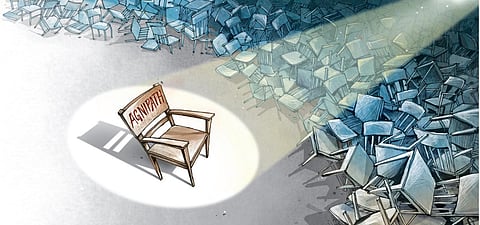

The former Prime Minister Dr. Manmohan Singh was often the subject of unfairly harsh criticism. One instance was when the economist in him said "money doesn't grow on trees" in response to questions about high fuel prices. As Finance Minister Nirmala Sitharaman finalises the Union Budget minutiae, she would be thanking Dr Singh: particularly as she prepares allocations for the controversial Agnipath scheme.
Shorn of rhetoric, this could be one of the most significant reform measures to maintain fiscal sanity. The numbers and data that show how important this is will follow soon. A quick recap of the Agnipath scheme first that had triggered violent protests across India in June, 2022 when it was announced.
Under this scheme, the armed forces will recruit 'soldiers' as it always does; but with a critical proviso. Just 25% of the soldiers will be absorbed as full time 'government employees' while the balance 75% will be asked to hit the civvy streets with a golden handshake of about Rs 1.1 million.
Many critics have slammed this new policy for various reasons. This write up is not about that. It is about the fiscal and monetary implications for the defence ministry as well as the exchequer as a whole.
Let's start with a Big Bang number first: according to government data, there were 34.1 lakh defence pensioners in 2021. Second place was occupied by the "largest employer" Indian Railways with 15.5 lakh pensioners. Department of Post pensioners straggled way behind with just 3.2 lakh pensioners. Between 2014 and 2021, the number of postal pensioners has remained static; that of Railway pensioners has gone up by 1.7 lakh and that of defence pensioners has gone up by 10 lakh.
Critics of the Agnipath scheme argue vehemently that soldiers are the cornerstone when it comes to defending the territorial sovereignty of India. They point out the continuing pesky efforts of Pakistan to unleash terrorism across western borders and the menacing threat of China across the eastern and northern borders.
Their contention: this "penny pinching" policy is akin to throwing the baby out with the bath water in the name of fiscal prudence. Perhaps they have a point. But anyone with a modicum of common sense will know that 21st century warfare will be as much about "hardware" as boots on the ground.
Hardware ranges from new aircraft to aircraft carriers to drones to tanks to artillery guns to cyber warfare tools. Where will the money for this come from? In fact, the money for hardware has become increasingly difficult to come; thanks mainly to pensions of retired soldiers and officers. As per government data, revenue expenditure (read salaries and pensions) accounted for 60% of the defence budget in 2010-11, with capital expenditure (read Rafale and the new INS Vikrant) getting the balance 40%.
By 2017-18, revenue expenditure took Rs 3 out of every Rs 4 in the defence budget, leaving just Rs 1 for hardware. Things have improved somewhat since then but salaries and pensions still took 70%, leaving 30% for hardware. The reason is not gobbledygook: pensions took 50% of the defence budget in 2021.
There is more data to shock people like you and me.
On January 31, 2022 when Nirmala Sitharaman presented the Union Budget, Rs 25000 crores was allocated as revenue expenditure for the Ministry of Women & Child Development; Rs 80000 crores for the Ministry of Health & Family Welfare; Rs 1.04 lakh crore for the Ministry of Education and Rs 1.19 lakh crores for defence pensions. Only the Home, Agriculture and Rural Development ministries got more money. How does one justify this?
The author belongs to a family with lots of armed forces personnel and has perhaps visited virtually every corner of India as their guests and interacted with 'faujis'. So this argument is not coming from an armchair analyst.
The bigger problem is demographics. A soldier usually retires between the age of 34 to 38; rarely touching 40. Prior to Agnipath, his pension as of today ranges from Rs 21,000 to Rs 23,000 per month, revised upwards when Dearness Allowance is hiked.
Now that does look like a paltry amount for someone who always risked his life for the country. It could well be. But when that paltry amount is multiplied by 3.4 million, things start looking different.
And then comes demographics. An overwhelming majority of retired soldiers today do not give their final salute till they are a least beyond 75 years of age. So they get pension for 40 years or so at least post-retirement, as do their widows till they pass away. Just imagine: without Agnipath, the number of defence pensioners would keep swelling beyond 34.1 lakh and given longer life spans, the pension bills will keep mounting for about a decade despite Agnipath.
The Agnipath scheme will make hardly any difference to the Budget numbers this time. When Dr Manmohan Singh presented his first Budget in 1991, cynics laughed at his talk about responsible financial behaviour. They are laughing at Nirmala Sitharaman too. But can the ordinary Indian citizen have the last laugh?
(Sutanu Guru is Executive Director, C Voter Foundation. He can be reached at sutanuguru@gmail.com.)